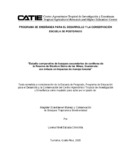Estudio comparativo de bosques secundarios de coníferas de la Reserva de Biosfera Sierra de las Minas, Guatemala: con énfasis en impactos de manejo forestal

View/
Date
2005Autor Corporativo
CATIE - Centro Agronómico Tropical de Investigación y Enseñanza
xmlui.dri2xhtml.METS-1.0.item-location
Turrialba, Costa Rica
Type
Tesis
Metadata
Show full item recordAlternative title
Comparative study of secondary coniferous forests in the Biosphere Reserve Sierra de las Minas, Guatemala: with an emphasis on the impacts of forest management
Description
Tesis (Mag.Sc.) -- CATIE, 2005
Abstract
El propósito de este estudio fue establecer impactos sobre la estructura del rodal y la comunidad de mariposas en bosques secundarios de coníferas de la Reserva de Biosfera Sierra de las Minas, en el oriente de Guatemala, con base en el manejo forestal y la variabilidad natural de los bosques bajo estudio además, pretendió colaborar con la validación de los enfoques de la Guía de Monitoreo Ecológico desarrollada por Finegan y colaboradores (2004). Mediante el muestreo de los indicadores mencionados, se detectaron niveles de cambio en un bosque de coníferas manejado, con respecto a un bosque de referencia, y se estableció si el grado de cambio se encontraba dentro de los límites aceptables o inaceptables. En cuanto a la definición del impacto del manejo en el BPJ, se evaluaron 6 indicadores con base en el protocolo de la Guía de Monitoreo, todos con un coeficiente de variación menor al 40 por ciento, el cual permitió fijar umbrales de cambio para el BR y activadores para el BPJ. El resto de los indicadores contó con un CV demasiado alto para ser evaluado por la guía. Todos los indicadores evaluados indican que el manejo es aceptable para este bosque. The purpose of this study was to establish te impacts on stand structure and the butterfly community in secondary coniferous forest in the Biosphere Reserve Sierra de las Minas, in eastern Guatemala, based on forest management and natural variability of the forest being studied in addition, this study helped to validate the focuses of the ecological monitoring guide developed by Finegan and collaborators (2004). By sampling the indicators mentioned, levels of change in a managed coniferous forest were detected with respect to a reference forest, and it was established if the degree of change was within the acceptable of unacceptable limits. Regarding the definition of management impact in the BPJ, 6 indicators were evaluated based on the monitoring guide protocol. All of the indicators had a variation coefficient (VC) less than 40 percent which determined change threshods for the RF and activators for the BPJ. The rest of theindicators had a VC too high to be evaluated by the guide. All of the indicators evaluated indicate that the management is acceptable for this forest.
Keywords
CARACTERÍSTICAS DEL RODAL, IMPACTO AMBIENTAL, CONIFERAS, ORDENACIÓN FORESTAL, GUATEMALA, RESERVAS DE LA BIOSFERA, BOSQUES TROPICALES, BIODIVERSIDAD, MUESTREO, VARIABILIDAD, COSTA RICA, SECONDARY FORESTS, STAND CHARACTERISTICS, LEPIDOPTERA, ENVIRONMENTAL IMPACT, CONIFERALES, FOREST MANAGEMENTLEPIDOPTERA,
Delegation
Sede Central
Asesor
Finegan, B.
Publisher
Centro Agronómico Tropical de Investigación y Enseñanza (CATIE)
URI (Permanet link to cite or share this item)
https://repositorio.catie.ac.cr/handle/11554/4640Collections
- Tesis [3111]

